I formulated something recently, which I'm going to share with you, if you want, but first I'm going to explain the whole context in which I formulated this, and this explanation is going to involve a lot of honesty on my part -- a lot of soul baring, if you understand -- which won't be pleasant but which I feel is important for me to express.
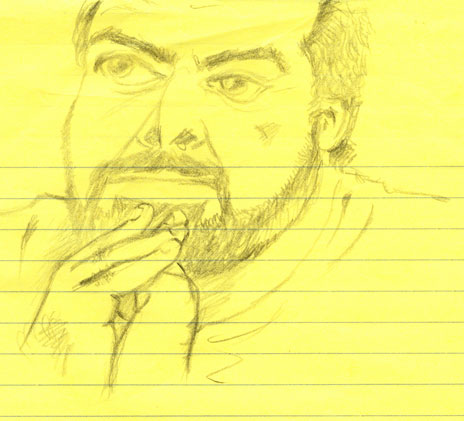 When I'm out, sometimes I draw people. Sometimes I draw men, but I usually draw women. I can't figure out exactly what it is, but I've spent a lot of time thinking about it, and I can figure out exactly what it isn't: It's not about anything perverted or weirdly sexual. These women don't figure in my fantasies. I don't imagine these women naked. I don't desire to possess them and in fact don't understand the concept of possessing other humans. (I really don't understand why on Valentine's Day you'd tell someone you supposedly love, "You are mine.") I can't fully explain my feelings. It's complex. I think there's a sense in which I want to tell the entire world to look at how absolutely wonderful this particular person is at this particular place at this particular time. Beyond that, the only other explanation I can come up with is to go back to Stendhal: "Beauty is the promise of happiness." Maybe I think these women can make me happy.
When I'm out, sometimes I draw people. Sometimes I draw men, but I usually draw women. I can't figure out exactly what it is, but I've spent a lot of time thinking about it, and I can figure out exactly what it isn't: It's not about anything perverted or weirdly sexual. These women don't figure in my fantasies. I don't imagine these women naked. I don't desire to possess them and in fact don't understand the concept of possessing other humans. (I really don't understand why on Valentine's Day you'd tell someone you supposedly love, "You are mine.") I can't fully explain my feelings. It's complex. I think there's a sense in which I want to tell the entire world to look at how absolutely wonderful this particular person is at this particular place at this particular time. Beyond that, the only other explanation I can come up with is to go back to Stendhal: "Beauty is the promise of happiness." Maybe I think these women can make me happy.
Of course they can't make me happy. Nothing can.
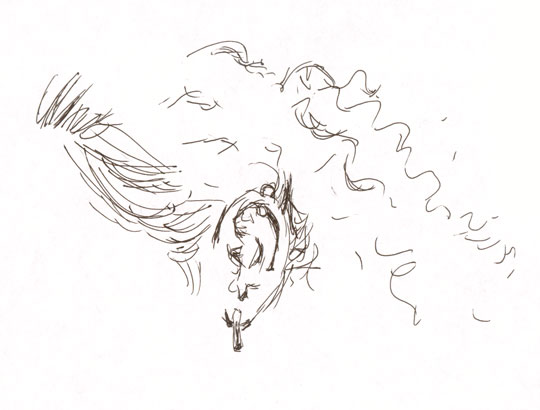 Whatever it is, I fall in love with these women. A friend of mine once tried to argue me out of this idea: He said, "You're smitten with her. You're not in love." But he's wrong. It's love, pure and simple. I don't understand it -- my current theory is it's some weird quirk of neurochemistry. That doesn't make it any less real, though.
Whatever it is, I fall in love with these women. A friend of mine once tried to argue me out of this idea: He said, "You're smitten with her. You're not in love." But he's wrong. It's love, pure and simple. I don't understand it -- my current theory is it's some weird quirk of neurochemistry. That doesn't make it any less real, though.
The funny thing depression has taught me is this: It's impossible to tell if something is entirely in your head because, in the end, everything you experience is entirely in your head. There's no way to tell if a feeling you have is "genuine" or generated by aberrant chemical reactions in your nervous system, because they're identical. You can look for a cause, for some chain of events outside yourself which instigated your feeling, but since you're doing this from inside your head, there's no way to tell if you've found an external cause or if your brain just made one up. The human brain, I've found, is adept at inventing proof of whatever it feels it needs to believe.
So it's love. I fall in love. And because I'm not the type of man who can walk up to strange women and profess his undying adoration, the women who I lean on most heavily tend to be women who, because of their profession, are required to pay attention and be nice to me, like waitresses, cashiers, and bank tellers.
I feel unutterably bad about this. One of the best inventions of all time is the automated call center; thanks to that, I can do most of my business over the phone without having to speak to a human being. For around twenty years economists have been talking about how great it is that we're moving towards a service economy, but I hate it. Not because I'm antisocial or despise human beings, but because I hate the idea of being serviced. I'd rather do it myself, whatever it is. The fact that a human being is required to make their living by providing me service is one I find abhorrent. Just from the clothes I buy and the stupid toys that come with my fast food and how much water I use in the shower I feel like I should be sleeping on a bed of human skulls every night. I don't need to enslave everyone I meet, too. I always use the self-checkout lane at the supermarket and I avoid supermarkets which don't have one. I've wandered around stores for hours looking for something because I don't want to bother anyone with asking them where to find it. I do my best to appear invisible whenever I'm forced to engage in commerce.
But until someone figures out how to automate waitressing and various other jobs, I'll have to deal with human beings, specifically women. And I'll fall in love, and I'll draw. And I'll feel bad that on top of having to service me, they also have to put up with my annoying habit of thinking I'm in love with them.
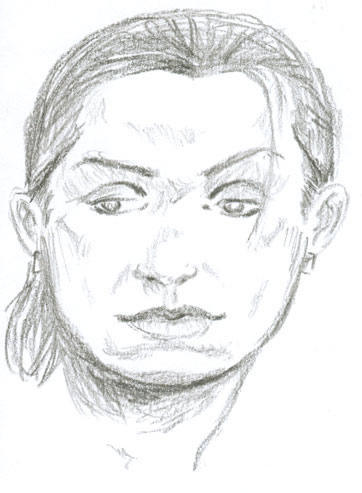 Most of my drawing like this I do in restaurants. I don't usually have a pad with me, but sometimes I do; and in some restaurants they give you a paper placemat and crayons. And it's easy for me to get bored sitting there, especially if I'm by myself, so I often end up doodling.
Most of my drawing like this I do in restaurants. I don't usually have a pad with me, but sometimes I do; and in some restaurants they give you a paper placemat and crayons. And it's easy for me to get bored sitting there, especially if I'm by myself, so I often end up doodling.
Now I know a true artist shouldn't lust after results. I should be happy with the process of drawing and not be concerned with the side effect, which is the drawing itself. But I'm not very good at not caring about my drawings. In fact, it breaks my heart to ever throw away any piece of paper on which I've drawn, doodled, scribbled, or scratched. Each one is special to me. Which is dumb, because I can always make another one, but there you go. I don't think these drawings of mine are very good, either. Part of this is because I'm just not a portraitist and part of it is because -- honestly -- I don't think I'm that talented.
So I do these drawings in restaurants and I can't bear to throw them away. Sometimes I keep them. Sometimes I leave them for the waitress. Occasionally -- very rarely -- someone notices what I've done and talks to me about it.
I really hate it when that happens.
This past Saturday night I was in Romano's Macaroni Grill, a pretty okay chain restaurant with a few outlets near my neighborhood. Romano's throws a big piece of paper over their tables and gives everyone crayons -- good Crayola crayons (specially made for the restaurant, maybe) with food names for all the colors -- so I usually end up drawing like crazy when I'm not playing tic tac toe with one of my kids.
One of the hostesses caught my eye. She was extremely thin and had a very long neck, like a Mannerist figure. Using a blue crayon, I sketched out a small portrait. (The drawing isn't one of the ones you can see here; I didn't keep it.) Of course I sketched this out right in front of me, where the plate would go and slop sauce all over it. I didn't like that idea, so I tore the drawing out and tucked it next to the salt shaker in the little citadel of menus and condiments in the center of the table. Then I commenced drawing a skateboarder doing an ollie on the paper in front of my son.
At the end of the meal our waitress noticed my drawing.
"That looks just like someone who works here!" she exclaimed. I sort of nodded and she called over another waitress who, I must admit, looked a lot more like the drawing than the model did. "Look!" our waitress said, excited, "It's you!"
The waitress who looked like my drawing looked at the drawing and then looked at me. I waved feebly.
I saw immediately that she had a story to tell her boyfriend that night. She could go home and say, "Today, Janey showed me this drawing someone did of me, and when I looked at the guy, I saw he was this big hairy ugly fucking troll."
While our waitress took the drawing saying she was going to pin it up on their board in the kitchen, I formulated these two axioms:
- A pretty woman is never surprised to be told how pretty she is. She knows how pretty she is to at least two decimal places.
- A pretty woman does not want to be told she is pretty by anyone who looks like me.
From these I have concluded:
- I should just stop.
- Just stop.
- Stop.
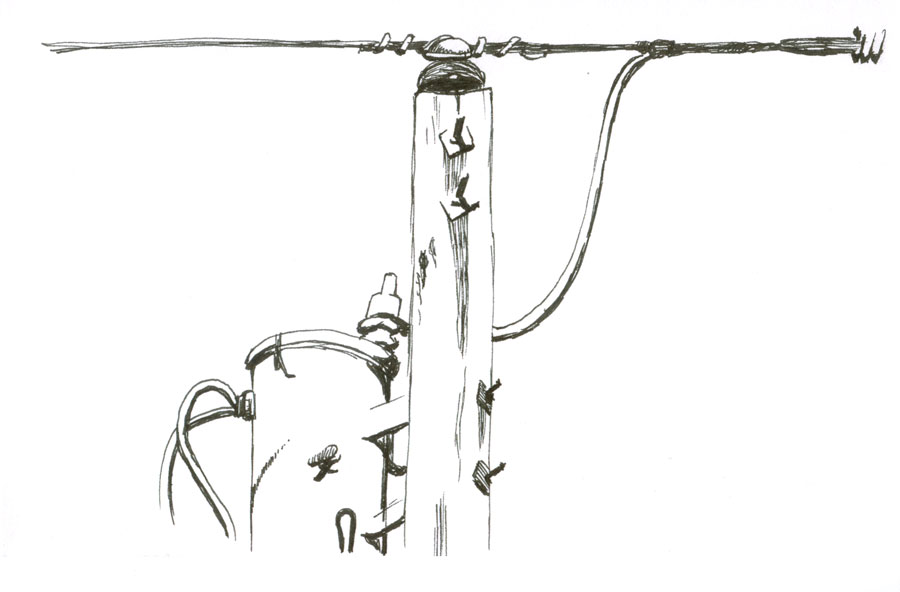 This is a transformer I drew while waiting to pick the kids up from school. It's about 8 by 10 inches. The drawing, not the transformer.
This is a transformer I drew while waiting to pick the kids up from school. It's about 8 by 10 inches. The drawing, not the transformer.
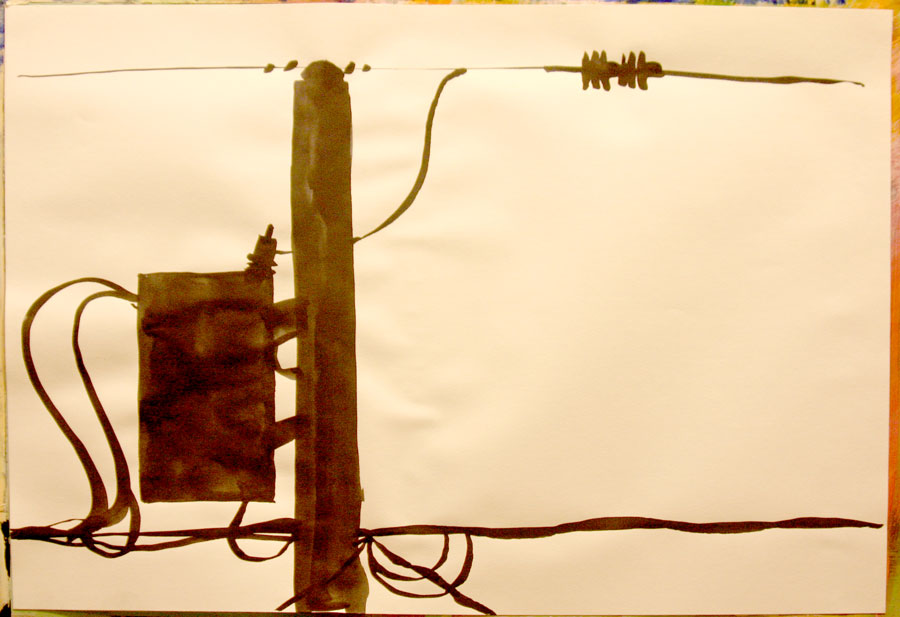 And this is a somewhat larger (too large for my scanner, hence the poor photo) ink and brush of the same subject, based on the earlier drawing. The plan is to use this in an upcoming traffic sign.
And this is a somewhat larger (too large for my scanner, hence the poor photo) ink and brush of the same subject, based on the earlier drawing. The plan is to use this in an upcoming traffic sign.
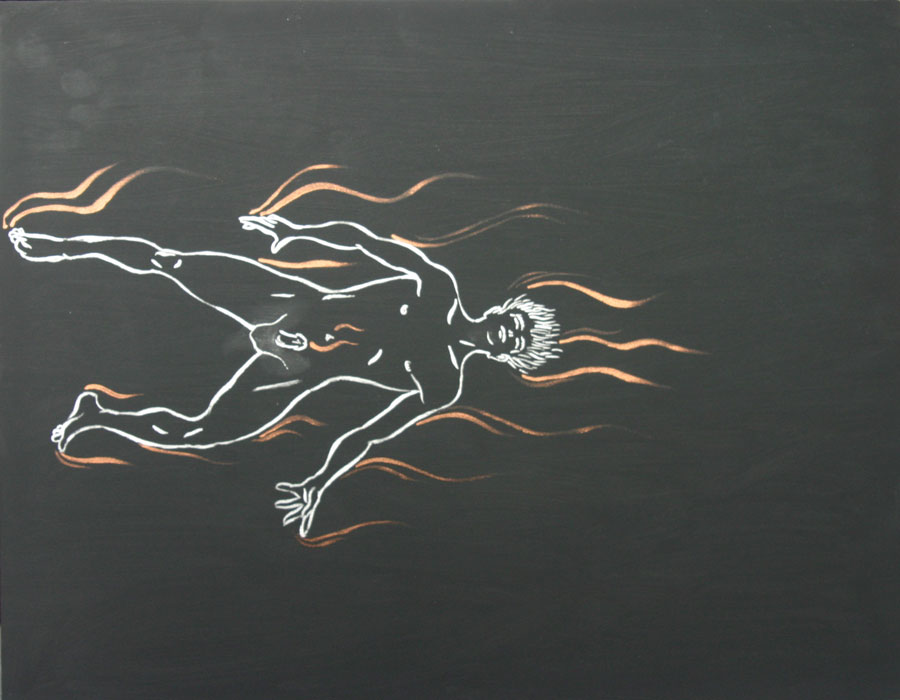 Someone commented, about my previous painting, that they'd seen better art on truck tire flaps. I replied that the person who first made that chrome silhouette of the reclining woman was a hero of mine. You might have thought I was joking.
Someone commented, about my previous painting, that they'd seen better art on truck tire flaps. I replied that the person who first made that chrome silhouette of the reclining woman was a hero of mine. You might have thought I was joking.
 When I'm out, sometimes I draw people. Sometimes I draw men, but I usually draw women. I can't figure out exactly what it is, but I've spent a lot of time thinking about it, and I can figure out exactly what it isn't: It's not about anything perverted or weirdly sexual. These women don't figure in my fantasies. I don't imagine these women naked. I don't desire to possess them and in fact don't understand the concept of possessing other humans. (I really don't understand why on Valentine's Day you'd tell someone you supposedly love, "You are mine.") I can't fully explain my feelings. It's complex. I think there's a sense in which I want to tell the entire world to look at how absolutely wonderful this particular person is at this particular place at this particular time. Beyond that, the only other explanation I can come up with is to go back to Stendhal: "Beauty is the promise of happiness." Maybe I think these women can make me happy.
When I'm out, sometimes I draw people. Sometimes I draw men, but I usually draw women. I can't figure out exactly what it is, but I've spent a lot of time thinking about it, and I can figure out exactly what it isn't: It's not about anything perverted or weirdly sexual. These women don't figure in my fantasies. I don't imagine these women naked. I don't desire to possess them and in fact don't understand the concept of possessing other humans. (I really don't understand why on Valentine's Day you'd tell someone you supposedly love, "You are mine.") I can't fully explain my feelings. It's complex. I think there's a sense in which I want to tell the entire world to look at how absolutely wonderful this particular person is at this particular place at this particular time. Beyond that, the only other explanation I can come up with is to go back to Stendhal: "Beauty is the promise of happiness." Maybe I think these women can make me happy.
 Whatever it is, I fall in love with these women. A friend of mine once tried to argue me out of this idea: He said, "You're smitten with her. You're not in love." But he's wrong. It's love, pure and simple. I don't understand it -- my current theory is it's some weird quirk of neurochemistry. That doesn't make it any less real, though.
Whatever it is, I fall in love with these women. A friend of mine once tried to argue me out of this idea: He said, "You're smitten with her. You're not in love." But he's wrong. It's love, pure and simple. I don't understand it -- my current theory is it's some weird quirk of neurochemistry. That doesn't make it any less real, though.
 Most of my drawing like this I do in restaurants. I don't usually have a pad with me, but sometimes I do; and in some restaurants they give you a paper placemat and crayons. And it's easy for me to get bored sitting there, especially if I'm by myself, so I often end up doodling.
Most of my drawing like this I do in restaurants. I don't usually have a pad with me, but sometimes I do; and in some restaurants they give you a paper placemat and crayons. And it's easy for me to get bored sitting there, especially if I'm by myself, so I often end up doodling.
 I've also been looking around me and thinking about capturing some of what passes people by. The kinds of things we see every day around here in northern New Jersey and don't pay much attention to. So I did this drawing of locust tree leaves -- there are a lot of locust trees around here -- using brush and ink.
I've also been looking around me and thinking about capturing some of what passes people by. The kinds of things we see every day around here in northern New Jersey and don't pay much attention to. So I did this drawing of locust tree leaves -- there are a lot of locust trees around here -- using brush and ink.
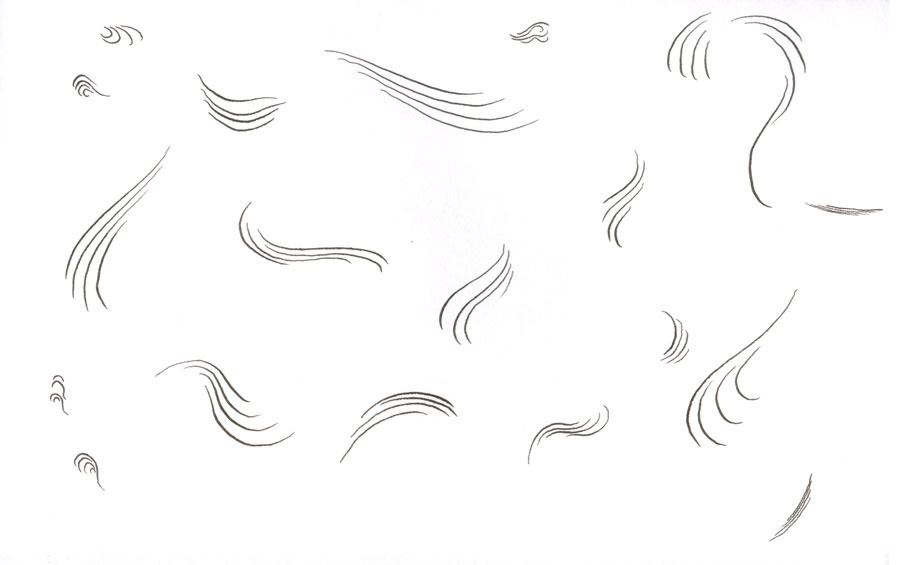
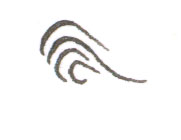
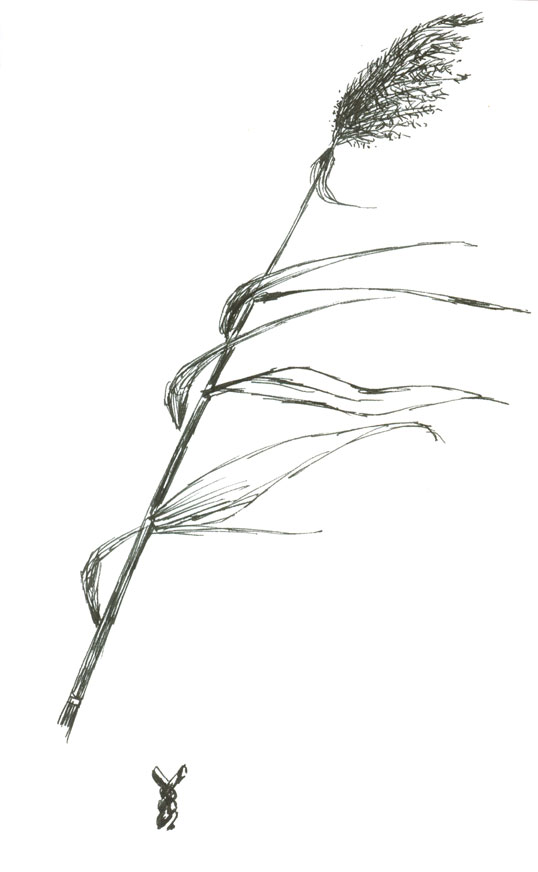 As I said, I've been looking at things we see but don't look at. One of the things northern New Jersey is positively awash in is reeds. They're what gives the Meadowlands its name, even though the acres of reeds don't make much of a meadow. It's more of a marsh. (Remember: Wet ground, short grass, bog; wet ground, tall grass, marsh; wet ground, trees, swamp.) I imagine early explorers from Europe landing on the northern New Jersey shoreline and seeing nothing but marsh and reeds stretching out as far as they can see and thinking, "Crap. How are we supposed to get across this?" Now, of course, we get across it extremely quickly on the New Jersey Turnpike, and we don't see the marsh at all. Or we get across it really, really slowly during rush hour, but then we're singing along with the car radio and not looking out the window anyway. Meanwhile people are draining the marsh and building stupid, ugly, worthless buildings on it as quickly as they can, and I'm thinking, we're going to miss the marsh when it's gone.
As I said, I've been looking at things we see but don't look at. One of the things northern New Jersey is positively awash in is reeds. They're what gives the Meadowlands its name, even though the acres of reeds don't make much of a meadow. It's more of a marsh. (Remember: Wet ground, short grass, bog; wet ground, tall grass, marsh; wet ground, trees, swamp.) I imagine early explorers from Europe landing on the northern New Jersey shoreline and seeing nothing but marsh and reeds stretching out as far as they can see and thinking, "Crap. How are we supposed to get across this?" Now, of course, we get across it extremely quickly on the New Jersey Turnpike, and we don't see the marsh at all. Or we get across it really, really slowly during rush hour, but then we're singing along with the car radio and not looking out the window anyway. Meanwhile people are draining the marsh and building stupid, ugly, worthless buildings on it as quickly as they can, and I'm thinking, we're going to miss the marsh when it's gone.
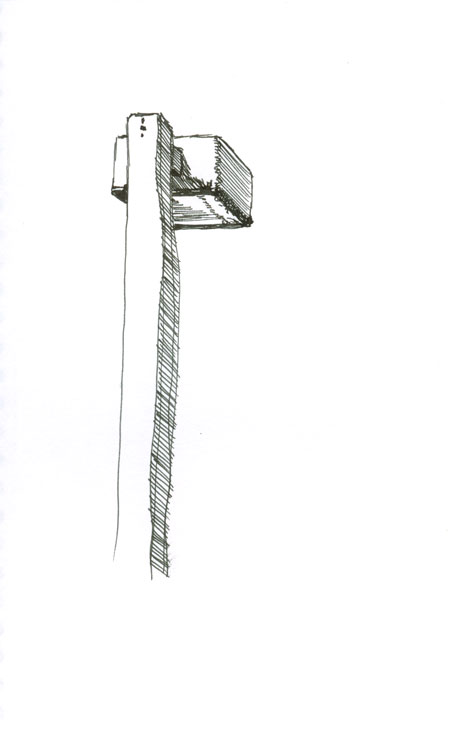 Hardly anyone else seems to think this, though, because all the towns in the area can't hand out building permits fast enough. We won't be happy until we're all within one Phragmites australis of at least four Home Depots, three Stapleses, two T.G.I. Friday'ses, and a Bed Bath and Beyond. Then we can all ignore all the parking lot lights instead of ignoring the reeds.
Hardly anyone else seems to think this, though, because all the towns in the area can't hand out building permits fast enough. We won't be happy until we're all within one Phragmites australis of at least four Home Depots, three Stapleses, two T.G.I. Friday'ses, and a Bed Bath and Beyond. Then we can all ignore all the parking lot lights instead of ignoring the reeds.

